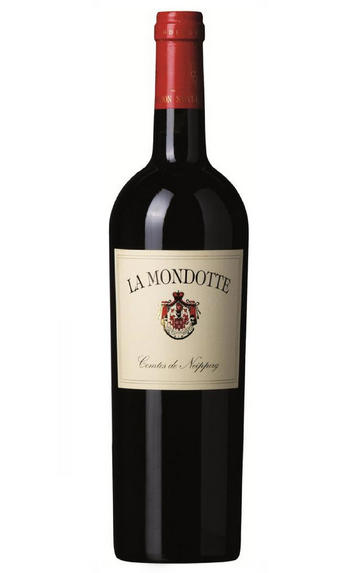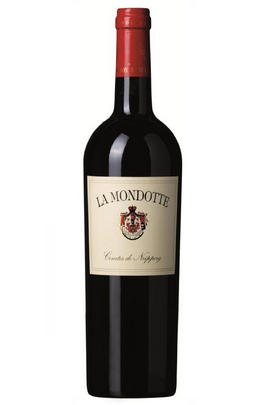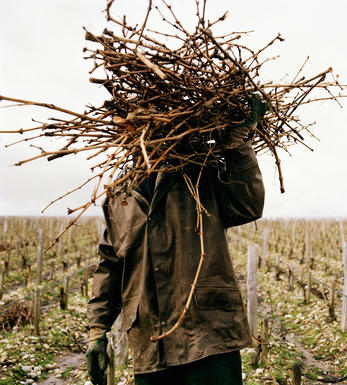
2021 La Mondotte, St Emilion, Bordeaux

Critics reviews
The 2021 La Mondotte was cropped at 45hL/ha between 30 September and 6 October and matured in 50% new oak. Suave on the nose, it offers dark berry fruit, incense and subtle cassis scents, that are very well integrated. Much less powerful than the La Mondotte of old. The palate is medium-bodied with pliant tannins, juicy and ripe, well balanced with a silky smooth finish. Perhaps what is just missing is a little grip and density, but it is well-crafted and fresh as a daisy.
Drink 2028 - 2042
Neal Martin, vinous.com, (May 2022)
The natural density that they have at Troplong was extremely helpful in a vintage like 2021. This is a little more reserved than a typical year, but very much delivers signature power. Expect gunsmoke, fern and raspberry leaf alongside cherry pit and saffron salinity, black cherry fruits, rosebud, anis, fennel spice, all with the powerful and concentrated signature of limestone. I was here on the last day of harvest, and I remember how healthy the grapes were. This is the first vintage where the cellar has been completely finished, moving from 20 to 42 tanks. No chaptilisation (but the natural 13.5%abv is extremely rare at this late ripening property, and a real indication of how long it took for sugars to climb in this vintage).
Drink 2025 - 2035
Jane Anson, janeanson.com (May 2022)
Dark and red-berry aromas with loads of chalky minerality. Tension and freshness from the terroir. Ripe fruit and tannins but slightly dry and chewy on the finish. Needs patience.
Drink 2028 - 2038
James Lawther, jancisrobinson.com (May 2022)
Unwinding in the glass with scents of cherry, sweet berries, dark chocolate and loamy soil, the 2021 La Mondotte is medium to full-bodied, lively and concentrated, with a compact, tightly wound profile, tangy acids and beautifully refined tannins. Of all the von Neipperg wines, this is the most reticent at this early stage, but all the components for a notable success are present.
William Kelley, Wine Advocate (Apr 2022)
A refined and firm-tannined red with violets, tangerines and blue fruit. Medium-bodied, tight and compact palate with everything in place. Elegance with structure.
James Suckling, jamessuckling.com (May 2022)
About this WINE

La Mondotte
La Mondotte is a tiny 4.5 hectare vineyard located just east of the St-Emilion limestone plateau between Troplong-Mondot and Tertre-Rôteboeuf. It is owned by Count Stefan von Neipperg who also owns Canon-La-Gaffelière.
In the early 1990s he tried to officially merge the vineyards of Mondotte and Canon-La-Gaffelière but was thwarted in his efforts by the governing authorities on the grounds that Canon-La-Gaffelière was a St. Emilion Grand Cru Classé and Château La Mondotte was not. Incensed, he set out to prove the authorities wrong by installing a fermentation facility at La Mondotte and showing what its terroir was capable of producing.
La Mondotte's clay-rich soils and the almost perfect aspect of the steep vineyards produce super-ripe Merlot grapes and a smaller proportion of Cabernet Franc grapes. These are fermented and then matured in 100% new oak barrels for 12-18 months.
La Mondotte produces extraordinarily rich, opulent and intense and are now increasingly difficult to find.

St Émilion
St Émilion is one of Bordeaux's largest producing appellations, producing more wine than Listrac, Moulis, St Estèphe, Pauillac, St Julien and Margaux put together. St Emilion has been producing wine for longer than the Médoc but its lack of accessibility to Bordeaux's port and market-restricted exports to mainland Europe meant the region initially did not enjoy the commercial success that funded the great châteaux of the Left Bank.
St Émilion itself is the prettiest of Bordeaux's wine towns, perched on top of the steep limestone slopes upon which many of the region's finest vineyards are situated. However, more than half of the appellation's vineyards lie on the plain between the town and the Dordogne River on sandy, alluvial soils with a sprinkling of gravel.
Further diversity is added by a small, complex gravel bed to the north-east of the region on the border with Pomerol. Atypically for St Émilion, this allows Cabernet Franc and, to a lesser extent, Cabernet Sauvignon to prosper and defines the personality of the great wines such as Ch. Cheval Blanc.
In the early 1990s there was an explosion of experimentation and evolution, leading to the rise of the garagistes, producers of deeply-concentrated wines made in very small quantities and offered at high prices. The appellation is also surrounded by four satellite appellations, Montagne, Lussac, Puisseguin and St. Georges, which enjoy a family similarity but not the complexity of the best wines.
St Émilion was first officially classified in 1954, and is the most meritocratic classification system in Bordeaux, as it is regularly amended. The most recent revision of the classification was in 2012

Merlot/Cabernet Franc
Merlot and Cabernet Franc are grape varieties commonly used in Bordeaux-style blends, particularly in the Bordeaux region of France. When these two grapes are blended, they can create a wine that combines the best characteristics of each variety.
Merlot is known for its smoothness, soft tannins, and ripe fruit flavours. It often contributes black cherry, plum, and chocolate flavours to the blend. The grapes are relatively easy to grow and ripen earlier than other Bordeaux varieties, making them versatile for blending.
Cabernet Franc, on the other hand, adds structure, depth, and complexity to the blend. It typically brings aromas of red fruits such as raspberry and strawberry, along with herbal notes like bell pepper and tobacco. These grapes have thinner skins and can be more challenging to cultivate, requiring specific growing conditions to reach their full potential.
When Merlot and Cabernet Franc are combined, the result is a well-balanced wine with various flavours and aromas. The blend often exhibits a Bordeaux wine's medium to full body, along with a smooth texture and moderate tannins. The specific flavour profile can vary depending on the proportions of each grape in the blend and the terroir and winemaking techniques employed.


Buying options
Add to wishlist
Description
The 2021 La Mondotte was cropped at 45hL/ha between 30 September and 6 October and matured in 50% new oak. Suave on the nose, it offers dark berry fruit, incense and subtle cassis scents, that are very well integrated. Much less powerful than the La Mondotte of old. The palate is medium-bodied with pliant tannins, juicy and ripe, well balanced with a silky smooth finish. Perhaps what is just missing is a little grip and density, but it is well-crafted and fresh as a daisy.
Drink 2028 - 2042
Neal Martin, vinous.com, (May 2022)
wine at a glance
Delivery and quality guarantee